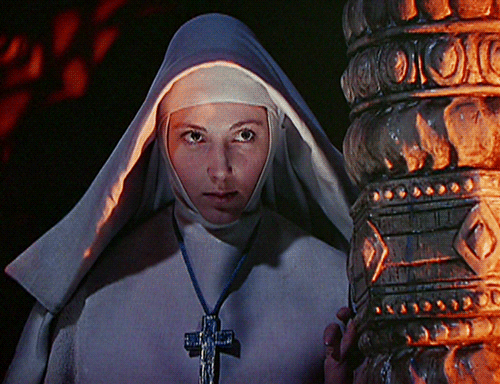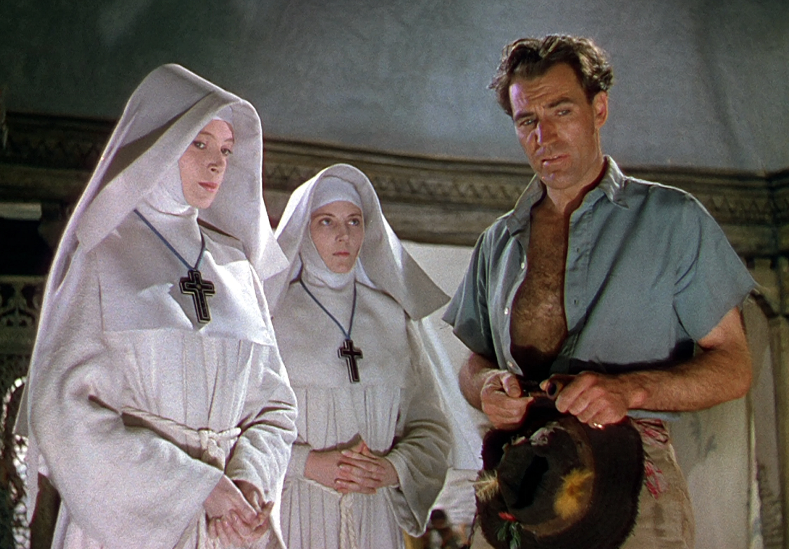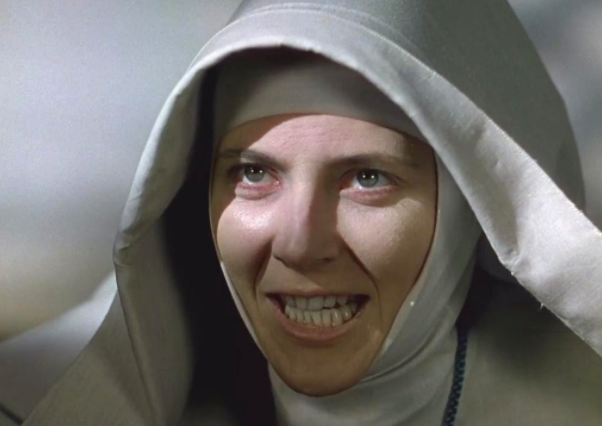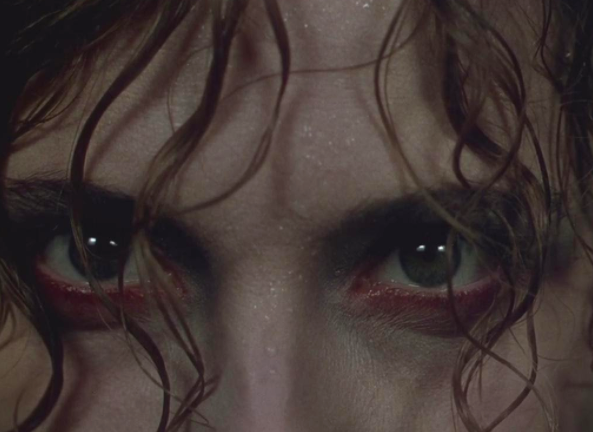1947: Kathleen Byron in "Black Narcissus"
 Friday, May 15, 2020 at 12:30PM
Friday, May 15, 2020 at 12:30PM by Nick Taylor

Ah, 1947. Back when the Golden Globes only announced their winners and neither NYFCC (age 12) nor NBR (age 2) had supporting acting categories. Searching for alternatives to Oscar’s lineup -- as we like to do when approaching a new Smackdown -- is appealingly open-ended. There are ways to find other options without awards bodies, though. The simplest is to call upon decades of film history to see which of any year’s most durable films have noteworthy female performances. For instance, has any other 1947 film so formidably established itself in the canon as Powell & Pressburger’s Black Narcissus... particularly as an offering of great actressing?
Centered on a group of Anglican nuns instructed to open a school on a Himalayan mountainside already infamous for scaring off other settlers, the film maintains the directors’ penchant for overripe atmosphere and jaw-dropping spectacle...

Black Narcissus boasts an indelibly multifaceted lead performance from Deborah Kerr as Sister Clodagh, the newly annointed leader of these nuns, but for the subject of this week’s article, we’ll be discussing Kathleen Byron’s obsidian supporting turn as Sister Ruth. This nun does not take well to this new setting but is very excited by the presence of a swarthy Englishman.
The very first thing we hear about Byron’s Sister Ruth is that she’s . . . . unwell, in a way neither Sister Clodagh nor her Reverend Mother feel quite comfortable describing in detail. They both seem concerned for Sister Ruth’s well-being but also a little frightened of whatever illness they’re implying, as though speaking it aloud might summon her. Sister Clodagh thinks Sister Ruth coming to this convent is a bad idea, likely to exacerbate her ill health, though the Reverend Mother believes the fresh mountain air may reinvigorate her. Even when we finally see Sister Ruth, her face as white as her robes and staring into the abyss as she rings the convent’s ornate, cliffside bell to signal the start of the day, her wrongness is hard to categorize but instantly present, especially once she starts grinning at an eerie horn blast that accompanies her ringing. Is she physically ill, or at least prone to illness? Is she psychologically disturbed? Is she just a bad person having a terrible time?

As it turns out, the answer given by Byron, Powell & Pressburger, and the film’s other artists is a resounding “all of the above”, portraying Sister Ruth as an already unstable figure pushed to the brink by this Himalayan outpost. By making her so unwell from the out and framing her fall as so self-mediated, her arc is shorn of any tragic or overtly sympathetic edges in favor of a doomed sense of inevitability. Sister Ruth’s status as an embodiment of repressed neuroses gone haywire couldn’t be more apparent. The fact that she bears a resemblance to Sister Clodagh automatically lends Sister Ruth more thematic weight as an extreme foil to her, yet Byron and her directors elevate Sister Ruth beyond a mere device. As maligned as she is, she’s never a reducible idea or a source of one-note villainy. It’s clear that among the non-Clodagh nuns, the character of Sister Ruth and Byron’s performance are given the most shaping by Powell & Pressburger, and Byron amply rewards their attention. Her expressions, movements, and postures are perfectly suited to her directors’ exaggerated style without resorting to caricature or overwhelming scenes that aren’t about her. She’s always a legible presence, modulating her gestures precisely no matter where she is in Cardiff’s compositions.
But Sister Ruth is as susceptible to physical maladies as she is psychological ones, and the film’s uncredited makeup team (listed here) takes great care with her appearance, giving her clammy, pale skin, chapped lips, and bloodshot eyes. Like Byron herself, these effects are able to register at all times, albeit in a less Gothic key. Byron dramatizes these illnesses in her bodily actions, sometimes rushing unsteadily from place to place or seeming visibly exhausted. In close-up she occasionally looks as though she’s trying to force her eyelids open to keep from fainting. Sister Ruth frequently looks as though she’s barely holding herself together, making the straight-backed vigor with which she rings the convent’s bell even more startling. There’s a great sense of purpose to her when she’s staring into the abyss or watching an object of her fascinations, one that never feels contradictory to her sickness or level os fatigue.

Part of what makes Sister Ruth’s madness so potent is the sheer size of it. Though all the nuns are bothered by this village and its people, Byron scales her own reactions slightly beyond these contexts. She certainly arrives with her own racist hang-ups and bad faith views of the locals, sourly trying to shoot down Sister Honey’s initial plans to teach the children English because they’re too stupid to understand her. It’s almost funny to see how much she doesn’t care about the children she’s been assigned to instruct, often not even pretending to teach them as she gazes out the window at Mr Dean or remaining lost in thought. But compared to the other Sisters, her breakdown feels more rooted in her growing dissatisfaction with the faith and her newly felt horniness than becoming unmoored by this specific environment. When Sister Ruth bursts into Sister Clodagh’s office to report the status of a new patient who nearly died from her injuries, she’s breathless but also a bit excited recounting the details of the ordeal while covered in the woman’s blood. It almost doesn’t matter who this person is or what part of the world they’re in, except that she has felt this stranger’s pain and is now energized by it. When she starts biting back against Sister Clodagh, the purity of her malice is frightening in its intensity and directness.
This is all the more impactful because Byron binds Sister Ruth’s obsessions into one concentrated force. Her erotic fixation on Mr Dean (which she plays as a girlish nervousness in their few interactions), her displacement in the convent, her jealous rivalry with Sister Clodagh: Byron shades all of these developments expertly while weaving them together as symptoms of the same mania. These threads culminate in a late-night confrontation with Sister Clodagh after she finds out out Sister Ruth intends to leave the order. Ruth opts to celebrate this with a massive transformation, one involving a whole new sense of style with colors that set her at violent odds with the desaturated, chalky white of the nunnery.

Her actions in the final third of Black Narcissus reach new extremes, seizing the opportunity to fulfill her deepest desires rather than just watching them, yet Byron’s performance remains fully controlled. She plays Ruth’s defiance of Sister Clodagh and her ardor for Mr Dean with a new level of intensity, kaleidoscopically shifting through these high-scaled emotions without sacrificing nuance or luxuriating in the camera’s already considerable attention. There’s nothing indulgent in Byron’s work, which feels as defined by its own might as it does a palpable sense of collaboration between her and her directors. Even as Ruth begins deteriorating in her final sequence, Byron maintains a technical skill and emotional directness that’s perfectly balanced to Powell & Pressburger’s narrative and aesthetic demands. You couldn’t get a Sister Ruth this affecting if Black Narcissus didn’t have the humid, overwhelming style of its direction, nor an actress so willing to meet those demands and enrich them with her own sense of danger and provocation. For all the folks who rightly deserve credit for the success of this character’s arc, there simply isn’t a Black Narcissus without Kathleen Byron.



Reader Comments (20)
That close up of her eyes was maybe the most frightening close-up on a pair of eyes I've ever seen. Should have the won the oscar for that alone.
It's also Kerr's best IMO. She would have been my 1947 actress winner.
Having recently rewatched the film I can fully agree that Byron is spectacular. Sometimes I feel performers can forget about their physicality in film but Byron fully invests her body into this performance. How she becomes a demon running around the chapel near the end of the film is frighteningly effecting. Her scenes with Kerr are electric and both actresses shine in ways I haven/t witnessed from either performer before or after.
It's a titanic performance that has stuck around and honestly overshadows any competition for the supporting prize in 47. I've watched a lot of films in preparation for the smackdown and no performance is as singular as the one delivered by Byron.
Black Narcissus didn't lose any of it's appeal in the rewatch and if anything grew in my estimation of it's brilliant. It's a beautiful film from the Cardiff photography, to the striking art direction, the ensemble of women and of course the confident direction by Powell and Pressburger, one of cinema's greatest directing teams.
It's a one of a kind and nowadays would be a shoe in for the win.
So glad to have this call out for 1947. Byron should have absolutely been in that Supporting Actress line up. Jane Greer in Out of the Past, Elsa Lanchester in The Bishop's Wife and Signe Hasso for A Double Life would also have made my line up.
One of the scariest non-horror performances ever! I love this film so much, even if certain aspects haven't aged so well.
Great critique!
I like this film but I LOVE Bryon's work in it and am mystified how she was not among the nominees. She just gets under Sister Ruth's very scary skin completely and though there were other fine performances this year she'd be my winner hands down.
Speaking of other performances none of the actual nominees would make my lineup (Gloria Grahame would be my sixth place choice)
My nominees would be:
Kathleen Bryon-Black Narcissus-Winner
Jane Greer-Out of the Past
Agnes Moorehead-Dark Passage
Helen Walker-Nightmare Alley
Shelley Winters-A Double Life
@Peter - She’s absolutely terrifying. Agreed on Kerr, too, though I should probably watch a few more lead performances from this year.
@Eoin - Her physicality is a huge boon in this. Not just when she’s running around but also the many ways she poses herself as she peers out windows. What a fright.
@thefilmjunkie - Parts that haven’t aged well? What brownface are you talking about?
Nick T: True, but Esmond Knight's role as The Old General is also basically a cameo. For the 40s, just be thankful that The Young General wasn't brownface as well, y'know?
Oh my God.... Kathleen Byron in Black Narcissus is a true high watermark for me. She completely owned the film for me. There is that air of a woman that is intriguing to watch as we watch her go mad. The scene where Sister Clodagh walks into Ruth's room as Ruth is wearing a red dress is mesmerizing while that moment where Ruth puts lipstick on was scandalous. It's a film that I'm happy to own on DVD as it's my 2nd favorite film by Powell and Pressburger as I also fell in love with Byron as I loved her in A Matter of Life and Death and the widely-underrated A Small Black Room.
I can't help watching this movie as an involuntary comedy and she totally rocks. I guess there's no bad Kathleen.
wonderful reading!
"a demented and vindictive soul can set the world on fire, Byron’s explosive menace is spot-on and spine-thrilling!" - cinema omnivore
She’s phenomenal in the film, but they overlooked Kerr for possibly her best perf in the leading category (Kerr and Jane Greer deserved a shot to Oscar, let alone the nom), so it’s not surprising they weren’t interested even in Byron
my supporting actress nominee of 1947
Kathleen Byron - Black Narcissus
Celeste Holme - Gentleman’s Agreement
Anne Revere - Gentleman’s Agreement
Natalie Wood - Miracle on 34th Street
Marjorie Main - The Egg and I
She is wonderfully demented specially after she puts on the dress and goes after Mr Dean
Byron is actually the runner-up to Kerr in NYFCC's best actress line-up. Its a pity they dun have supp category then, which Byron wld most certainly have won!
Black Narcissus shld've been nom for Best Pic, Dir, Actress & Supp Actress!! It missed those noms mainly bcos its a British production + the sensitive subject matter. But even the Academy cannot denied the stupendous cinematography + production designs (art direction), which Black Narcissus deservedly won!!
Sidenote: Jane Greer is great in Out of The Past, but she is the female LEAD, not a supp player, thx u v much!
As Danny Peary's classic "Guide for the Film Fanatic" memorably said of this film, "An erotic masterpiece about nuns!"
I have adored this film for fifty years, and it may even be my favorite of the Powell-Pressburger trifecta (has anybody else ever made three films as great as A Matter of Life and Death, Black Narcissus, and The Red Shoes back to back?!?!?!?) Deborah Kerr gives a tremendous performance, but Kathleen Byron is the power character. What presence! Quick notes:
Re brownface that hasn't aged well, don't forget Jean Simmons as Kanji. Not that I don't love Jean Simmons!
Bryon and Powell were romantic partners when the film was made.
DP Jack Cardiff and production designer Alfred Junge were geniuses: incredibly, this film was entirely shot on a soundstage apart from the rain sequence at the end!
Look for Kathleen Byron showing up in old lady roles decades later - The Elephant Man, Emma, Saving Private Ryan.
A BBC miniseries of Black Narcissus is coming, with Gemma Arterton and Alessandro Nivola; Wiki page: https://en.wikipedia.org/wiki/Black_Narcissus_(miniseries)
And finally, I always thought "Crazy Sister Ruth" would be great name for a punk band!
Doctor Strange: Sticking to features, that might go up to six, honestly. Haven't seen I Know Where I'm Going!, but the epic Colonel Blimp and the thrillingly gross in that 40s way A Canterbury Tale (remember: The glue would NOT be glue in a modern production) are also there.
Oh, I completely agree! The Life and Death of Colonel Blimp is masterful and unique. A Canterbury Tale is a fascinating snapshot of England during the war. And you'll find that I Know Where I'm Going! is also excellent. (It's sitting on my DVR right now to show my daughter.) Don't forget Forty-Ninth Parallel either.
I never skip a chance to recommend ANY Powell & Pressburger film! The lesser ones are merely fascinating, and the good ones... well, you know.
And a special shout-out to Tales of Hoffmann - the most bizarre, psychedelic studio film made between Fantasia and 2001: A Space Odyssey.
Mr Dean is one hot furry daddy
Saw this movie last weekend and it blew my mind. Sister Ruth gave me the creeps near the end...in the best way possible of course. Who could forget that close up?
Any other movies that starred Kathleen that are worth seeing? I've already seen A Matter of Life and Death and The Small Black Room but both weren't exactly my thing.